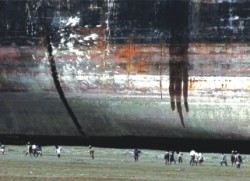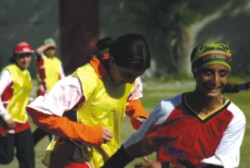Film
Travelling Film
South Asia 2010
Jessica Mudditt
 |
The Last Rites |
This year's Travelling Film South Asia festival showcased 12 of the best documentaries to emerge from South Asia within the last two years. The festival was held at the Central Public Library in Shabagh, Dhaka and was organised by BEGINNING, a creative studio that aims to promote film-making in Bangladesh, and it was supported by the Manusher Jonno Foundation and South Asians for Human Rights.
Two Bangladeshi films, “The Last Rites” by director Yasmine Kabir and “The Promised Land” by director Tanvir Mokammel were outstanding, both in terms of content and aesthetics.
“The Last Rites” is a 17 minute film about the ship-breaking yards of Chittagong, where thousands of men risk life and limb as they dismantle the enormous vessels that have grown too old to be useful. The film's haunting score contains only high-pitched howling winds and assorted industrial noises. The workers appear so tiny in contrast to the vast ships that it seems utterly inconceivable that they could ever be broken down into small pieces. The men are blown about in the wind like ants in a teacup as they toil with steel ropes, metal plates, gas cylinders and oil sludge. Children are also depicted as members of the half-starved workforce - in a particularly moving scene, two small boys swing on a rope hanging off the side of a “dead” ship, as though determined to reclaim a small part of their youth. Yasmine Kabir said of her film, “I would like to instil a sense of empathy in the viewer for the plight of the workers, and for it to remain an historical record of the tragedy of ship-breaking.”
“The Promised Land” is a documentary about the Urdu-speaking minority who live in 116 camps throughout Bangladesh. Many of the “Biharis”, as they are also known, left the Indian state of Bihar for the newly created East Pakistan in 1947. During the Liberation War, they became embroiled in conflict and after the nine-month war was over, they moved into refugee camps for their own security, as resentment against them ran high amongst Bangladeshis. Thirty-eight years later, 116,000 Urdu speakers remain in the camps and live in unspeakable squalor. The film documents the atrocities committed by both sides during the Liberation War via interviews with survivors, as well as surveying the views of young Urdu-speakers who feel that Bangladesh is the only place they call home. The film also portrays the sense of betrayal the older members of the community feel towards the Pakistani government, who did not repatriate all those who wished to move there. The most poignant aspects of the film are those that centre on the upheaval endured by families and the heartache of those who remain separated from their loved ones.
“The Way of the Road,” by British directors and brothers Ben and Cosmo Campbell, is set in the Himalayas, in the border area between Nepal and Tibet. In 2012 a road will be built connecting the two ethnically distinct areas and the film documents what this might mean for the Tamang villagers, who are desperately poor and hoping for increased opportunities through trade. However some are sceptical about the road's future benefits and fear that the road could adversely affect their livelihoods. The film also includes a colourful re-enactment of Tibetan and Nepali armies in conflict, which demonstrates how their identities have long been shaped by living in a border area.
 |
Afghan Girls Can Kick |
“The Salt Stories” by Indian director Lalit Vachani is a heartfelt and often amusing tale of a camera crew retracing the steps of Mahatma Gandhi as he marched 241 miles in a brilliant act of civil disobedience against the English colonialists. The film crew have a special connection to Gandhi -- their cameraman is none other than his great-grandson, though he keeps this stunning fact rather quiet. After 80 years, Gandhi is still a revered figure in many towns, whilst in others, no one is even aware that he passed through on his historic mission in 1930. At that time, Gandhi succeeded in gaining the world's sympathy as images of police brutality against those protesting were printed across the globe. Although the film reflects that independence was not achieved for another 17 years, it leaves no doubt in the viewer's mind that the salt march was a triumph of the highest order.
“In Search of the Riyal” by Nepalese director Kesang Tseten provides a glimpse of what happens when workers go to the Gulf to work as labourers in the searing heat of its deserts. This film has a strong resonance in Bangladesh, as around four million Bangladeshis have immigrated to Gulf states since Bangladesh started sending construction workers in 1976. This film is based in Qatar, though it also portrays the villages in Nepal where employment is painfully scarce and the men feel they have little choice but to leave their wives, children and parents for an uncertain future. They are frightened and anxious - and sadly, for good reason. As well as working in truly grim conditions, many are denied their salary month after month, and they are beaten and ill-treated by their bosses. This film should be commended for shedding light on a situation that is chronically under-reported due to the Gulf's sensitivity to scrutiny of their labour practices.
"Afghan Girls Can Kick" by Iranian director Bahareh Hosseini is a 'fly-on-the-wall' account of Afghanistan's first ever women's national football team. The young women break the stereotypical mould set for them by a conservative society as well as reflecting more broadly on the changes to their lives since the days of the brutal Taliban regime.
“The Battle for Pakistan” by Karachi based director Maheen Zia, focuses on the mushrooming of madrasas in Pakistan. It provides a fascinating investigation into the government's fight to regulate the institutions and to curb the rise in extremism, with varying degrees of success.
“Children of God” by Nepalese director Yi Seung-jun is set in a crematorium in a Kathmandu temple. It portrays the children who scavenge for the food and money that was offered during funerals. The children struggle to stay alive on the morsels they find from the families of the dead. Their pragmatism in the face of the afterlife is both touching and sad.
“Come to My Country: Journeys with Kabir and Friends” by Indian director Shabnam Virmani is somewhat similar to “The Salt Stories” as it focuses on a historical figure and their relationship with the modern world. The object of the documentary is Kabir, the 15th century mystic poet of northern India. The film interweaves the stories of two very different people - Indian folk singer Prahlad Tippanya and North American scholar Linda Hess. The two are brought together through an unlikely friendship brought about by the cross-cultural resonance of Kabir.
"Mayomi" by UK director Carol Salter is set in post-Tsunami Sri Lanka. A young woman struggles to hold her family together. Her father is disabled, her brother is alcoholic and she must care for his abandoned six-year-old son. She must also fight against the forces of corruption and an inefficient bureaucracy. Mayomi does so with great dignity and humility.
“Out of Thin Air” by Indian directors Samreen Farooqui and Shabani Hassanwalia contains films within a film. Whilst the Ladakh film industry has gone from strength to strength, the lives of the locals involved in filmmaking are anything but glamourous. However as the film proves, this does not mean that they do not lead interesting lives. The film is pegged as providing “a look into the Ladakh missing from post cards."
"Saamam" ("The Music") by Indian director Ramachandran K is an attempt to make sense of an overwhelming amount of memories about a classical music genius, the late M D Ramanathan. It aims to bring the essence of traditional classical art forms to international audiences.
Anyone who sampled even a small selection of these films would easily conclude that the Travelling Film South Asia festival has once again demonstrated that the sub-region is rich in diversity, humanity and talent.
Copyright
(R) thedailystar.net 2010 |
